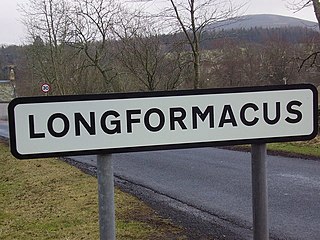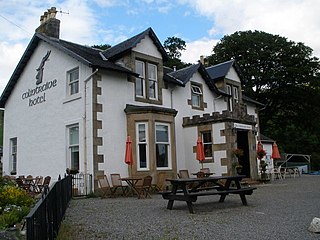Related Research Articles

Portsoy is a town in Aberdeenshire, Scotland. Historically, Portsoy was in Banffshire. The original name may come from Port Saoithe, meaning "saithe harbour". Portsoy is located on the Moray Firth coast of northeast Scotland, 50 miles (80 km) northwest of Aberdeen and 65 miles (105 km) east of Inverness. It had a population of 1,752 at the time of the 2011 census.

Braemar Castle is situated near the village of Braemar in Aberdeenshire, Scotland. It is a possession of the chief of Clan Farquharson and is leased to a local charitable foundation. It is open to the public.

Francis Hindes Groome was a writer and foremost commentator of his time on the Romani people, their language, life, history, customs, beliefs, and lore.

Denny is a town in the Falkirk council area of Scotland. Historically in Stirlingshire, it is situated 7 miles west of Falkirk, and 6 miles (10 km) northeast of Cumbernauld, adjacent to both the M80 and M876 motorways. At the 2011 census, Denny had a resident population of 8,300.

Oldhamstocks or Aldhamstocks is a civil parish and small village in the east of East Lothian, Scotland, adjacent to the Scottish Borders and overlooking the North Sea. It is located 6 miles (10 km) south-east of Dunbar and has a population of 193. The church was consecrated by Bishop David de Bernham, 19 October 1242. Its chancel is a fine example of late Gothic — probably fifteenth-century work.

Longformacus is a small village in Berwickshire in the Scottish Borders area of Scotland. It is around 10 kilometres (6.2 mi) north-west of Duns, in the Lammermuir Hills. The Dye Water runs through the village, flowing east towards its confluence with the Whiteadder Water nearby.
The 77th Regiment of Foot (Montgomerie's Highlanders) was a Highland Scots Regiment raised in 1757. The 77th Regiment was one of the first three Highland Regiments to fight in North America. During the Seven Years' War, the regiment lost 110 soldiers and 259 were wounded.

Aberchalder is a small settlement and estate at the northern end of Loch Oich in the Scottish Highlands and is in the Highland council area of Scotland. It lies on the A82 road and is situated in two parishes, Boleskine and Kilmonivaig. Fort Augustus is within 5 mi (8.0 km).
Manrent refers to a Scottish contract of the mid-15th century to the early 17th century, usually military in nature and involving Scottish clans. The bond of manrent was commonly an instrument in which a weaker man or clan pledged to serve, in return for protection, a stronger lord or clan—in effect becoming a vassal that renders service to a superior, often made in the form of a covenant. Manrents were a Promise by one person to serve another, [such] that he shall be friend to all his friends, and foe to all his foes.

Achnahannet is a hamlet located northwest of Dulnain Bridge, and three and a half miles west-south-west of Grantown-on-Spey, in the historical county of Morayshire, now in the Highland Council area, Scotland. Historically it belonged to the parish of Cromdale.
Thomas McLauchlan (1815–1886) was a Scottish minister and theological author who served as Moderator of the General Assembly for the Free Church of Scotland 1876/77.
The surname Gow is a sept of the Clan Macpherson, a Highland Scottish clan. The Clan Macpherson are in turn a member of the confederation of the Clan Chattan. Within the clan the surname Smith is considered synonymous with that of Gow and this is due to the family's progenitor being either of the surname Smith or of having been of the occupation of Blacksmith. They are known in Scottish Gaelic as the Sliochd an Gobh Cruim which means "the race of the crooked smith".
Bracholy is a place and former parish in Highland, Scotland. The parish was united with the parish of Petty, prior to the Reformation.
John Merry Ross (1833–1883) was Scottish academic author and teacher. He was an expert on British poetry.

The Colintraive Hotel is a hotel and pub in Colintraive, Argyll and Bute, Scotland. It was formerly a hunting lodge for John Crichton-Stuart, 7th Marquess of Bute. It stands a few yards from the eastern shores of the Kyles of Bute and the ferry crossing of the 400-yard gap to Rhubodach on Bute, currently provided by the MV Loch Dunvegan.

Craigie is a residential area of Perth, Scotland, immediately to the south and southwest of the city centre, beyond the South Inch. It is situated in the foothills of the 430 feet (130 m) St Magdalene's Hill, over which the M90 motorway passes, as does the B9112. It is separated from the city by the Highland Main Line.

Pitcur is a hamlet at the eastern edge of Perth and Kinross, Scotland, about 2.5 miles (4.0 km) southeast of Coupar Angus.

Ordnance Gazetteer of Scotland: A Graphic and Accurate Description of Every Place in Scotland is a book by Francis Hindes Groome. It was published in 1901, by T. C. and E. C. Jack of Edinburgh, combining six volumes written between 1884 and 1885, along with initial revisions made in 1895 and subsequent smaller revisions. It has entries for all of Scotland's cities, towns, villages and hamlets, beginning with Aven in today's Aberdeenshire and concluding with Zetland, the former name of Shetland. It also includes tourist attractions, historical sites and the histories of family names and clans.
Thomas Allan Croal was a British historian and author. He wrote, or contributed to, several publications during the late 19th- and early 20th centuries, including A Book About Travelling, Past and Present (1877), Scottish Loch Scenery (1882) and Palaces and Prisons of Mary, Queen of Scots.
Walter Scott Dalgleish was a British historian and author. His publications include Great Speeches from Shakespeare's Plays: with Notes and a Life of Shakespeare (1891), Great Britain and Ireland, 1689–1887 (1895) and Mediaeval England, from the English Settlement to the Reformation (1896).
References
- 1 2 Melven, William - WorldCat
- ↑ Groome, Francis Hindes (1885). Ordnance Gazetteer of Scotland: A Survey of Scottish Topography, Staistical, Biographical and Historical. T. C. Jack.